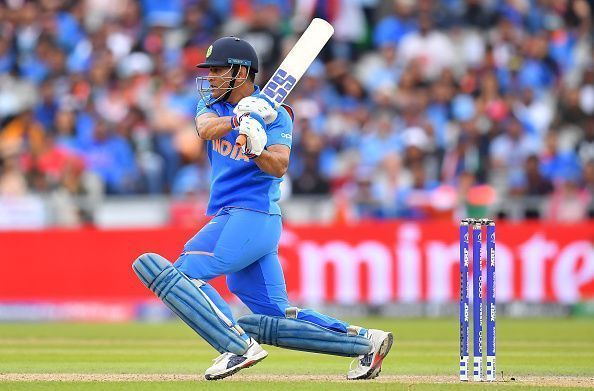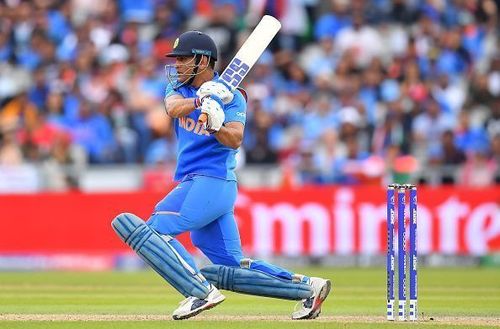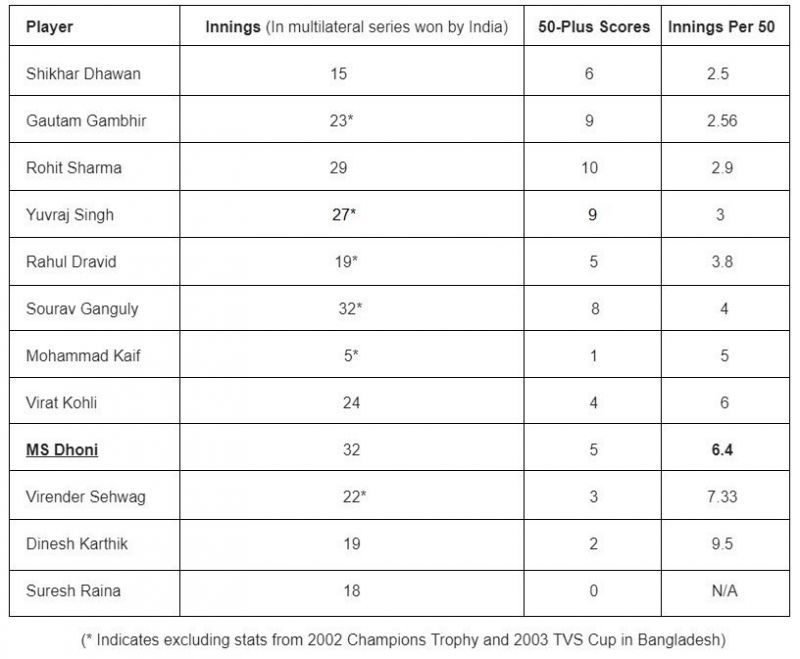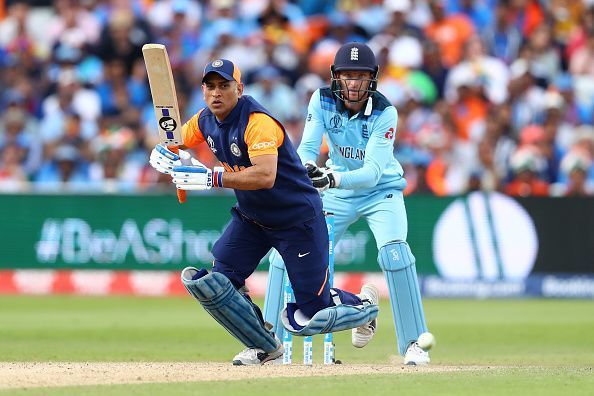
10 surprising facts about MS Dhoni you might not know

For over 14 years now, Mahendra Singh Dhoni has enjoyed an excellent status in Indian cricket. Right from his international debut in December 2014 to now, Dhoni has only been rested and never been dropped from the team in any format. He has often called his own shots, and the only such Indian cricketer from the past two generations to enjoy such a luxury was Sachin Tendulkar.
Every other Indian batsman (or cricketer in the last 20 years), right from Sourav Ganguly to Rahul Dravid, and from Rohit Sharma to Virat Kohli has been dropped at least once during the course of their careers. This has happened despite the fact that their responsibility at the crease is much higher than that of Dhoni, who has usually batted lower down the order after these batsmen.
However, MS Dhoni has never been dropped since his debut. He was only rested on the odd occasion, such as the Test leg during the Sri Lanka tour of 2008, and was never forced to perform at the domestic level to stake a claim in any format.
In fact, even Sachin Tendulkar, who managed to score at least one half century in almost every tournament he played, was indirectly asked by the selectors about his retirement plans from ODI cricket after which he himself decided to called time on his career.
Undoubtedly, MS Dhoni holds a legendary status in Indian cricket. A major reason for this is his success as a limited overs captain, and the tournaments India won under his leadership.
This, despite the fact that of the World Cup winning captains to have led their side in 150 or more matches, Ricky Ponting (71.73%) and Allan Border (60.11%) enjoyed a better winning percentage than Dhoni's 55% (110 wins in 200 matches).
Among other players to have led their team in 100 or more matches, Wasim Akram, Hansie Crojne, Steve Waugh, Vivian Richards, AB De Villiers and Graeme Smith have a better winning percentage than Dhoni's. But now that Dhoni's captaincy is already a thing of the past, one wouldn't want to dwell further into his captaincy statistics.
Also, his ODI average of above 50 ranks him among the best one-day batsmen of all time, But a deep analysis of these statistics would help you look at the other side of the picture. No one can doubt Dhoni's potential as a world-class cricketer, and he deserves all the laurels and applause he has gathered during the course of his international career.
But you also cannot question the fact that he has not been the same cricketer as before in the last two years.
Since January 2017, he has not scored a single century and has rarely maintained a strike rate of more than 100. 2018 was the most disastrous year for him as he could not manage a single half century in 13 innings, with calls for his axing just months before the World Cup.
However, he resurrected his career with three back to back fifties during India's maiden bilateral ODI series victory in Australia earlier this year. Dhoni was expected to hit top form during what could have been his last World Cup, but even his fans knew that he was nowhere near his prime, and that potentially cost India a place in the tournament final.
Despite a bad patch and lack of intent from previous years, Virat Kohli backed Dhoni as much as a captain possibly can. Now that the World Cup is done and dusted with, this is the perfect time to sit back and look at some facts.
While one would find a number of articles on the internet singing praises of Dhoni's legend, the following statistics highlight some of the drawbacks of his career. Let us look at each of these statistics, and discuss them in detail.
[1] - In multilateral ODI tournaments that India have won, Dhoni's contribution is five half-centuries from 32 innings. In the two multilateral T20I tournament victories he has participated in, he does not have a single half century in ten innings. In India's three ICC tournament victories, Dhoni has one half century from 20 innings. Also, he has not scored a single century in any of the nine multilateral tournaments he has won as a player - despite having played all the matches in all those tournaments.
Though he has individually enjoyed a few standout performances in India's ODI tournament victories - such as the 2011 World Cup Final and the 2013 Celkon Cup Final - his performance through the rest of all those tournaments has been quite disappointing.
Let us compare this statistic with all Indian batsmen who have played 45 or more ODIs (and at least two or more years) with MS Dhoni. We will only look at the batting records of these players during comparisons.
For fair purposes, we have excluded Sachin Tendulkar, who will undoubtedly surpass many other Indian cricketers, with the huge number of tournaments he won for India right from the 90's till the 2011 World Cup. Add to this the fifty-plus scores he registered in finals, and he will surpass any other Indian cricketer by the virtue of those knocks.
Also, since most of Sachin's innings from tournaments that India won are from the 90's, while most of Dhoni's such innings are from the 2010's. It would hence be unfair to compare performances from two strikingly different eras.

You can clearly see that MS Dhoni is ninth on the list and only scores a fifty in no less than six innings when India wins multilateral tournaments. He usually prefers to stay in the background.
The list also does not include performances from India's 2002 Champions Trophy campaign (where India shared the title with Sri Lanka), and 2003 TVS Cup in Bangladesh (which India shared with South Africa), else Virender Sehwag would have toppled Dhoni by the virtue of his multiple 50-plus scores in those tournaments.
Also Sourav Ganguly, Rahul Dravid, Yuvraj Singh, Gautam Gambhir and even Mohammad Kaif would have bettered their record if those stats would have been included. Kaif played at number seven in most of the multilateral tournament victories and shared trophies he has been part of, while Yuvraj has also batted below number five in most of these tournaments.
For convinience sake, the tournaments along with the featured players who played at least one innings in each of the respective tournament are as follows:
(i) 1996 Titan Cup - Rahul Dravid, Sourav Ganguly
(ii) 1998 Independence Cup - Sourav Ganguly
(iii) 1998 Coca-Cola Cup (Australia, New Zealand) in Sharjah - Sourav Ganguly
(iv) 1998 Coca-Cola Tri Series (Bangladesh, Kenya) in India - Rahul Dravid, Sourav Ganguly
(v) 1998 Akai-Nidahas Trophy - Sourav Ganguly
(vi) 1998 Coca-Cola Tri Series (Zimbabwe, Sri Lanka) in Sharjah - Rahul Dravid, Sourav Ganguly
(vii) 2002 Natwest Series - Rahul Dravid, Sourav Ganguly, Virender Sehwag, Mohammad Kaif, Yuvraj Singh
(vii) 2008 CB Series - Virender Sehwag, Yuvraj Singh, MS Dhoni, Gautam Gambhir, Rohit Sharma
(viii) 2009 Compaq Cup - Rahul Dravid, MS Dhoni, Yuvraj Singh, Virat Kohli, Suresh Raina
(ix) 2010 Asia Cup - Virender Sehwag, MS Dhoni, Dinesh Karthik, Gautam Gambhir, Rohit Sharma, Virat Kohli, Suresh Raina
(x) 2011 ICC World Cup - Virender Sehwag, MS Dhoni, Yuvraj Singh, Gautam Gambhir, Virat Kohli, Suresh Raina
(xi) 2013 ICC Champions Trophy - MS Dhoni, Rohit Sharma, Shikhar Dhawan, Virat Kohli, Dinesh Karthik, Suresh Raina
(xii) 2013 Celkon Cup (West Indies) - MS Dhoni, Rohit Sharma, Shikhar Dhawan, Virat Kohli, Dinesh Karthik, Suresh Raina
(xiii) 2018 Asia Cup - MS Dhoni, Rohit Sharma, Shikhar Dhawan, Dinesh Karthik
Also, Rohit Sharma, Shikhar Dhawan, Virat Kohli, Yuvraj Singh, Virender Sehwag, Gautam Gambhir and Robin Uthappa have all scored at least one half century in the two multilateral T20 tournaments (ICC World T20 2007 and Asia Cup T20 2016) that India have won till date. Dhoni could not reach 50 in either of the 10 innings in those tournaments.
[2]- In the four World Cups in which Dhoni has appeared, his record stands pale when compared to all other Indian batsmen who have played a minimum of 10 innings in those tournaments.
Top averages from World Cup 2007, 2011, 2015 and 2019 combined are-
(i) Yuvraj, 498 runs in 11 innings at 71.14, 6 fifty-plus scores
(ii) Rohit Sharma: 978 runs in 17 innings, at 65.2; with 9 fifty-plus scores
(iii) Shikhar Dhawan: 537 runs in 10 innings at 53.7; 4 fifty-plus scores
(iv) Sachin Tendulkar, 546 in 12 innings at 49.63, 5 fifty-plus scores
(v) MS Dhoni, 780 in 25 innings at 43.33, 5 fifty-plus scores.
(vi) Virat Kohli, 1030 runs in 26 innings at 42.91; 8 fifty-plus scores
Though Virat Kohli's record is not as good as he would have wanted it to be, he has more fifty-plus scores than Dhoni and is prone to getting out more often as he bats up the order. Plus, in terms of runs-per-innings, Dhoni averages only 31.2, which is worse than any other batsman on this list. The second lowest runs-per-innings average is Virat Kohli's 39.61.
[3] Even in the four ICC Champions Trophy tournaments that Dhoni has appeared in, his record stands pale when compared to all other Indian batsmen to have played six or more innings in those tournaments.
Top averages from ICC Champions Trophy 2006, 2009, 2013 and 2017 combined-
(i) Dhawan: 701 in 10 innings at 77.89 with 6 fifty-plus scores.
(ii) Kohli: 529 in 13 innings at 75.57 with 5 fifty-plus scores.
(iii) Rohit: 481 in 10 innings at 53.44 with 4 fifty-plus scores.
(iv) Yuvraj: 159 in 6 innings at 39.75 with one fifty-plus score.
(v) Dhoni:: 183 in 8 innings at 22.87 with 2 fifty-plus scores.
To make things worse, India have lost both the ICC Champions Trophy matches in which Dhoni scored half centuries. All other batsmen have at least one 50-plus match winning score, and India have won all matches when either Virat or Yuvraj has scored 50 or more.
[4] - Dhoni and big match pressure:
Dhoni did not adapt to the pressure early on in his career as he failed miserably in the 2005 Indian Oil Cup final and the 2005 Videocon Cup final. He managed only 29 runs from three innings in the 2007 World Cup, which included one duck each in the matches against Bangladesh and Sri Lanka. By 2008, during the Kitply Cup Final and Asia Cup Final, Dhoni showed some promise but failed to take India to the target.
By now, his strategy was to play out the good bowlers - even if it meant running out of partners. This was precisely one of the reasons India failed in many big matches, including the 2008 Kitply Cup Final, 2008 Asia Cup Final, 2010 Sri Lanka Triangular Series Final, 2015 World Cup Semifinal and 2019 World Cup Semifinal.
ODI cricket is about partnerships where both batsmen contribute in similar proportion. Even the 2011 World Cup final might have ended in a difficult chase, had Gambhir departed immediately after Kohli. Dhoni and Gambhir's 109-run partnership off 118 balls was crucial in getting India close to the target that night.
In all tournament finals (14) Dhoni has played, he has scored 487 runs at an average of 44.27. Though this record appears decent, he has scored only four fifties and multiple not outs in these fourteen innings.
What is even more disappointing is that only two of those fifties have resulted in victories. His only other innings of some note in tournament finals is his 45 not out in the 2013 Celkon Cup Final against Sri Lanka while chasing a target of 202.
[5] - Out of 83 fifty-plus scores in ODIs, none have come in matches where India have successfully chased a set target of 300 or above. Statistically, only his 183 not out against Sri Lanka at Jaipur in October 2005 came in a successful chase when India scored 300 or more, although their target was only 299.

[6] Stuttering in stiff chases: During his 50 against New Zealand in the recently concluded World Cup 2019 semifinal at Manchester, Dhoni showed little intent in scoring boundaries in the middle overs. In fact, early on in his innings, he showed little intent in rotating the strike as well - a characteristic of most of his innings in the last two years.
While his approach during the match against England in the group stage of this World Cup was questioned, his poor start in the matches against Afghanistan, West Indies and Bangladesh escaped criticism only because India won those matches. Dhoni should have attacked for all money during the England match, which could have given the team a lot more confidence.
These innings were only a fraction of Dhoni's many blunders in stiff chases throughout his career. He has often left it for too late and even in many small tournament matches, Dhoni has hogged a lot of the strike. While he is is not the only reason India lost these matches, but a lack of strategy from Dhoni did not help India's case either.
A harsh truth is that Dhoni's high average is a product of his ability to remain unbeaten and fifties in low pressure matches, mostly from bilateral series. It is a product of finishing many easy matches, attacking only in the death overs whenever India batted first and only saving his wicket in near impossible chases.
Had Yuvraj and Kaif decided to just save their wicket to secure their position in the team during the 2002 Lord's final, Indian cricket might not have transformed and inspired a generation of champion batsmen - Virat Kohli included.
[7] - There is an argument about Dhoni batting at the No.4 position in ODIs. While he enjoys a decent record at that position, he embraced the responsibility during the home ODI series against South Africa in 2015 and later relinquished it himself.
Unfortunately, the truth is that the other batsmen are affected by the constant shuffle in the batting order. However, if the team and Dhoni both feel that he is their number four batsman for the next World Cup, they better decide now.
[8] None of his ten ODI centuries have come in multilateral tournaments that India have won or in knockout matches of any multilateral tournament. His only two centuries in multilateral tournaments are a 109 not out against Hong Kong during the 2008 Asia Cup and a 101 not out against Bangladesh in Mirpur during the 2010 tri-series there.
His last ODI hundred came in January 2017. Even then, Yuvraj Singh, who was fighting for a place in the side counterattacked and scored 150. While Yuvraj got to his first 50 off just 56 balls even after India were 25 for 3, Dhoni took 68 balls to get to his half century.
Dhoni now begins his innings in even slower fashion, such as scoring 1 off his first 10 balls, or 4 off his first 20 balls, which is not acceptable in today's ODI cricket.
[9] Also, Dhoni the T20 star (internationally) is a myth. Here is a comparison of his T20I record and records in the IPL.
T20I: 85 innings, 1617 Runs, Average: 37.60, SR: 126.13, 50's: 2, Innings per fifty - 43.50.
IPL: 170 innings, 4432 Runs, Average: 42.21, SR: 137.85, 50's: 23, Innings per fifty - 7.39.
Other T20s: 28 innings, 552 runs, Average: 30.67, SR: 143.37, 50's: 2, Innings per fifty - 14
Total: 283 innings, 6621 runs, Average 39.88, 50's: 27, SR: 135.62, Innings per fifty: 10.48
Even though his sample space for IPL is much bigger, his record in the franchise league is so much better and consistent compared to his international statistics. IPL is more viewed than any T20I, and is viewed as a competition of international significance. Hence, viewers tend to mix Dhoni's IPL record with his T20I record, and ignore his failures in the latter.
Also, the fact that Dhoni bats around some of the most experienced batsmen at CSK sheds light on this. In fact, he gets equal or more opportunities to bat in international T20Is, where India are ranked 5th, and have won only one World T20 and a T20 Asia Cup, two of their only multilateral tournament victories in the format.
Like all other players, Dhoni has been tested a lot as India have managed to win only 22 out of the 46 T20 tournaments they have participated in. He has played 98 out of India's 115 T20 international matches, batting 85 times.
[10] - Dhoni scored his maiden T20 International fifty in his 66th inning, after forfeiting captaincy and after having captained India in six T20 World Cups. This was also after over ten years of playing T20 cricket at the international level. He scored only one more the following year, and so far has only two half centuries to boast from a total of 85 innings in 98 matches.
All said and done, he will remain one of India's best wicket keeper batsman across formats, and India's best limited overs format captain for a long time.
Dhoni took some bold decisions at arguably the right time, including player selections. But now is the time Kohli takes a decision on Dhoni for good. The ex-captain's running between the wickets, strike rotation efficiency and wicket keeping reflexes are also not as good as they once used to be and it could be time that upcoming talent is groomed.
At the end of the day, no player is bigger than the game and the team's demands - whether it is Sachin Tendulkar, MS Dhoni or even Virat Kohli.